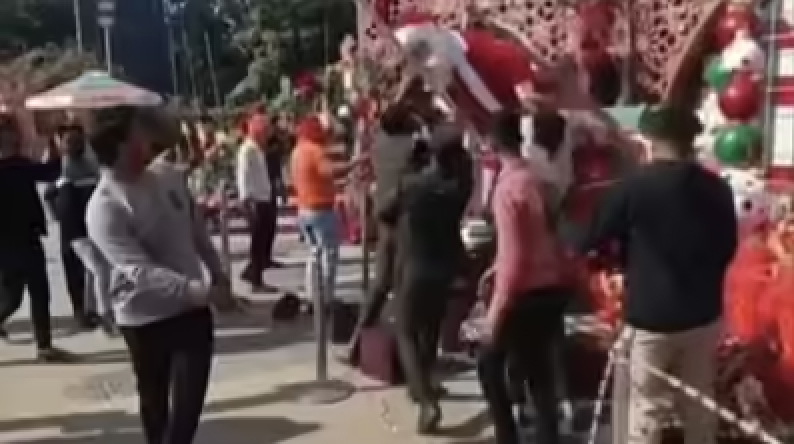
By Rajendran Narayanan / The Hindu
The fist-raised, burqa-clad figure of the young student walking courageously amidst the white noise of saffron-sporting hecklers underscores the routine acrimony and structural violence faced by Muslims in India today. Earlier, fraternity was the norm, occasionally punctuated by violence. It is the opposite now.
I present three vignettes here. The first is based on a visit last month with four others to Naragund taluk in Gadag district of Karnataka, as part of a platform of pluralist organisations called Bahutva Karnataka . It was a solidarity visit after we heard news reports of the murder of a 19-year-old Muslim man called Sameer Shahpur. The other two vignettes are stories of friendship from earlier times that showcase a more harmonious tapestry of India, and serve as capsules of pluralism for lost patriots.
On the morning of January 17, various Hindutva outfits took out a rally from a temple to Naragund police station where incendiary speeches were made against Muslims, notably by a Bajrang Dal leader. Referring to Muslims as “terrorists” and “dogs”, they said, “we will not spare them (Muslims).”
Later that evening, when Sameer was returning home on a motorcycle with his friend, Shamseer Khan, all the roads leading to his home were blocked by a Hindutva mob. Sameer was riding the motorcycle. Both Sameer and Shamseer were stabbed with lethal weapons by the mob. Sameer died the next morning but Shamseer miraculously survived. One of those making the hate speech, also allegedly involved in Sameer’s murder, was arrested later. Sameer may have been alive today had the police registered an FIR or arrested the perpetrators of the hate speech that morning.
We also learned of a 17-year-old Muslim student of a government college in Naragund who was dragged out of his classroom by a mob of nearly 100 people and beaten up inside the principal’s office. When we asked him why he was beaten up, he said, with a deadpan face, “I guess because I am Muslim.” In the same town, in December, a 15-year-old Muslim boy was assaulted inside his school by a Hindutva mob. These mobs had members belonging to the Akhil Bharatiya Vidyarthi Parishad, the student wing of the BJP.
I returned to Bengaluru with these distressing stories and narrated them to my mother, Lalitha. She is a retired school teacher who taught at a Christian-run school in Kolkata for 35 years. She vividly recalled her days as a college student in Government College, Kumbakonam, in the early 60s. Kumbakonam is a small, ancient town in Tamil Nadu’s Thanjavur district with a dominant Hindu Brahmin community. Less than 10% of the town is Muslim.
Walking together
She recollected how the route to her home from college was, on many occasions, a den of heckling Hindu men. She fondly remembered her Muslim classmate and friend, Ansari, who would walk with her to safeguard her from harassment. She got married a few years later and invited Ansari. His wedding present to her was a Tamil book titled Teachings of Ramakrishna Paramhansa.
My mother and I sat in silence trying to process the present times. The next day, a friend asked us to join them to visit Narasimha Swamy temple, about 80 km from Bengaluru. We hired a taxi and the driver was a pleasant Muslim man in his early 60s, dressed in a white kurta pyjama and skull cap. His name was Gulab.
Upon reaching, we had some difficulty finding the entrance to the temple. From inside the taxi, we called out to a priest who was passing by in white dhoti and saffron stole. Gulab began by asking for directions in Kannada but soon the two were laughing and deep in conversation. Having recognised each other from days gone by, they now enquired after each other’s well-being, and that of their families, as we sat back and listened with involuntary smiles on our faces.
Afterwards, we asked Gulab about the serendipitous exchange in this faraway place. He said the priest and he were friends. They had worked together in the 80s and 90s when he was a bus driver with the Karnataka State Road Transport Corporation, and the priest was a bus conductor.
My mother’s recollection of her college friend Ansari and Gulab’s exchange with the priest stood out in sharp contrast to the harrowed and hapless look on the faces of the family members of Sameer and Shamseer. When we met Shamseer at the hospital, his eyes turned moist when he spoke of his friend. “Sameer never troubled anyone,” he said. It was Shamseer’s motorcycle that Sameer had been riding on the day of the tragic incident.
Shamseer’s tryst reminded me of ‘A Song for the Deceased Pilot’ by Russian singer Vladimir Vysotsky. It’s about a pilot who returns home from a war that has taken his friend and fellow pilot’s life. The survivor imagines how his friend’s family might feel when they see him return home alone:
“ I did not ask for favours, nor was favoured by Fortune,
I did not seek reserves to be as snug as a bug;
But the women’s eyes always
reprimanded me watching:
‘And if only you’d stayed there
forever,
Then perhaps my man would
have come back.’
I came up with an earnest: “Please
forgive, I’m alive!
By pure chance I’m returning,
returning,
But he failed to survive.”
One will never fully know the pain and trauma suffered by Shamseer and Sameer’s families. What we do know is that the poison spread by Hindutva groups is a recent, ugly blot on the fabric of a more inclusive India that my mother, Ansari, Gulab, and the priest have experienced.
This article first appeared on thehindu.com






